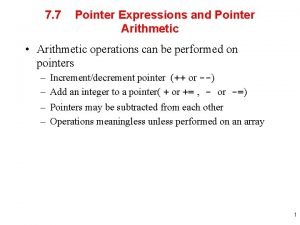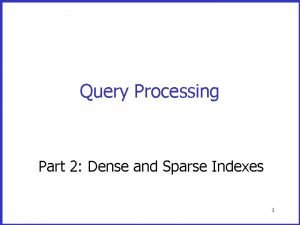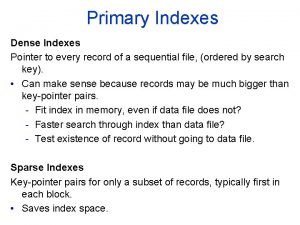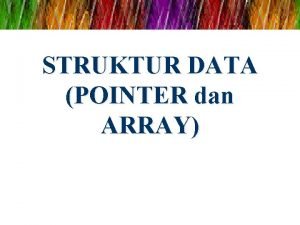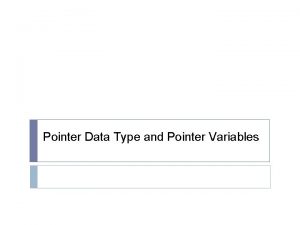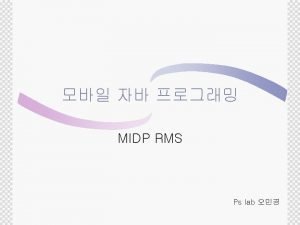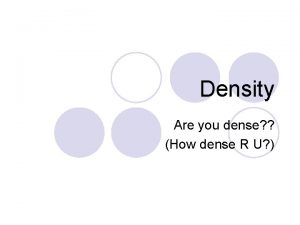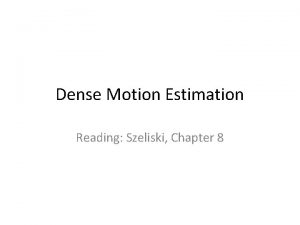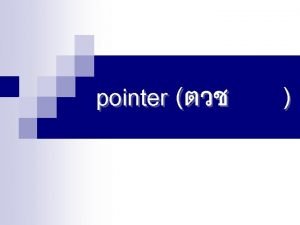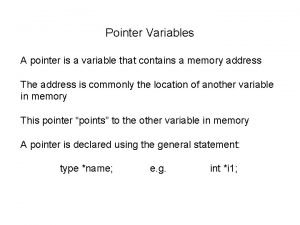Primary Indexes Dense Indexes Pointer to every record



































- Slides: 35

Primary Indexes Dense Indexes Pointer to every record of a sequential file, (ordered by search key). • Can make sense because records may be much bigger than key pointer pairs. - Fit index in memory, even if data file does not? - Faster search through index than data file? - Test existence of record without going to data file. Sparse Indexes Key pointer pairs for only a subset of records, typically first in each block. • Saves index space.

Dense Index

Num. Example of Dense Index • Data file = 1, 000 tuples that fit 10 at a time into a block of 4096 bytes (4 KB) • 100, 000 blocks data file = 400 MB • Index file: Key 30 Bytes, pointer 8 Bytes 100 (key, pointer) pairs in a block • 10, 000 blocks = 40 MB index file might fit into main memory

Sparse Index

Num. Example of Sparse Index • Data file and block sizes as before • One (key, pointer) record for the first record of every block index file = 100, 000 records = 100, 000 * 38 Bytes = 1, 000 blocks = 4 MB • If the index file could fit in main memory 1 disk I/O to find record given the key

Lookup for key K Issues: sparse vs. dense? 1. Find key K in dense index; 2. Find largest key K in sparse. Follow pointer. a) Dense: just follow. b) Sparse: follow to block, examine block. Dense vs. Sparse: Dense index can answer: ”Is there is a record with key K? ” Sparse index can not!

Cost of Lookup • We do binary search. • So, how many I/O we need to find the desired record in the file? • log 2 (number of index blocks) • All binary searches to the index will start at the block in the middle, then at 1/4 and 3/4 points, 1/8, 3/8, 5/8, 7/8. • So, if we store some of these blocks in main memory, I/O’s will be significantly lower. • For our example: Binary search in the index may use at most log 10, 000 = 14 blocks (or I/O’s) to find the record, given the key, … or much less if we store some of the index blocks as above.

Delete 30 with dense index

Delete 30 with dense index

Delete 30 with sparse index

Delete 30 with sparse index

Insert 15 With Sparse Index

Insert 15 With Sparse Index Redistribute

Use Overflow Block Instead Similarly, we can have overflow blocks with dense indexes as well. …that’s a messy approach.

Secondary Indexes • A primary index is an index on a sorted file. • Such an index “controls” the placement of records to be “primary, ” • Secondary index = index that does not control placement, surely not on a file sorted by its search key. - Sparse, secondary index makes no sense. - Usually, search key is not a “key. ”

Indirect Buckets • To avoid repeating keys in index, use a level of indirection, called buckets. • Additional advantage: allows intersection of sets of records without looking at records themselves. • Example Movies(title, year, length, studio. Name); secondary indexes on studio. Name and year. SELECT title FROM Movies WHERE studio. Name = 'Disney' AND year = 1995;


Inverted Indexes • Similar (to secondary indexes) idea from information retrieval community, but: - Record document. - Search keyvalue of record presence of a word in a document. • Usually used with “buckets. ”

Additional Information in Buckets • We can extend bucket to include role, position of word, e. g. Type Position

B Trees Generalizes multilevel index. • Number of levels varies with size of data file, but is often 3. • B+ tree = form we'll discuss. - All nodes have same format: n keys, n + 1 pointers. • Useful for primary, secondary indexes, primary keys, nonkeys. • Leaf has at least • Interior nodes use at least key pointer pairs pointers.

A typical leaf and interior node (unclusttered index) Leaf 57 81 95 To next leaf in sequence To record with key 57 Interior Node To keys K<57 To record with key 81 with key 95 57 81 To keys 57 K<81 57, 81, and 95 95 To keys 81 K<95 To keys K 95 are the least keys we can reach by via the corresponding pointers.

Lookup 13 7 2 3 5 7 23 11 13 17 19 31 23 Try to find a record with search key 40. 43 29 31 37 41 43 Recursive procedure: • If we are at a leaf, look among the keys there. If the i-th key is K, the i-th pointer will take us to the desired record. • If we are at an internal node with keys K 1, K 2, …, Kn, then if K<K 1 we follow the first pointer, if K 1 K<K 2 we follow the second pointer, and so on. 47

Insertion into B Trees • We try to find a place for the new key in the appropriate leaf, and we put it there if there is room. • If there is no room in the proper leaf, we split the leaf into two and divide the keys between the two new nodes, so each is half full or just over half full. • The splitting of nodes at one level appears to the level above as if a new key pointer pair needs to be inserted at that higher level. - We may thus apply this strategy to insert at the next level: if there is room, insert it; if not, split the parent node and continue up the tree. • As an exception, if we try to insert into the root, and there is no room, then we split the root into two nodes and create a new root at the next higher level; - The new root has the two nodes resulting from the split as its children.

Insertion Try to insert a search key = 40. First, lookup for it, in order to find where to insert. 13 7 2 3 5 7 23 11 13 17 19 31 23 43 29 31 37 41 43 47 It has to go here, but the node is full!

Beginning of the insertion of key 40 13 7 2 3 5 7 23 11 13 17 19 31 23 43 29 31 What’s the problem? No parent yet for the new node! 43 37 40 Observe the new node and the redistribution of keys and pointers 41 47

Continuing of the Insertion of key 40 We must now insert a pointer to the new leaf into this node. We must also associate with this pointer the key 40, which is the least key reachable through the new leaf. But the node is full. Thus it too must split! 13 7 2 3 5 7 23 11 13 17 19 31 23 43 29 31 43 37 40 41 47

Completing of the Insertion of key 40 13 This is a new node. 7 2 3 5 7 23 11 13 17 19 43 31 23 • We have to redistribute 3 keys and 4 pointers. • We leave three pointers in the existing node and give two pointers to the new node. 43 goes in the new node. • But where the key 40 goes? • 40 is the least key reachable via the new node. 29 31 43 37 40 41 47

Completing of the Insertion of key 40 13 It goes here! 40 is the least key reachable via the new node. 40 7 2 3 5 7 23 11 13 17 19 43 31 23 29 31 43 37 40 41 47

Structure of B trees • Degree n means that all nodes have space for n search keys and n+1 pointers • Node = block • Let - block size be 4096 Bytes, - key 4 Bytes, - pointer 8 Bytes. • Let’s solve for n: 4 n + 8(n+1) 4096 n 340 n = degree = order = fanout

Example • n = 340, however a typical node has 255 keys • At level 3 we have: 2552 nodes, which means 2553 16 220 records can be indexed. • Suppose record = 1024 Bytes we can index a file of size 16 220 210 16 GB • If the root is kept in main memory accessing a record requires 3 disk I/O

Deletion Suppose we delete key=7 13 7 2 3 5 7 23 11 13 17 19 31 23 43 29 31 37 41 43 47

Deletion (Raising a key to parent) 13 5 23 11 13 17 19 31 23 43 29 31 37 41 43 47

Deletion Suppose we delete now key=11. No siblings with enough keys to borrow. 13 5 23 11 13 17 19 31 23 43 29 31 37 41 43 47

Deletion 13 23 2 3 5 13 17 We merge. However, the parent ends up to not have any key. 19 31 23 43 29 31 37 41 43 47

Deletion 23 31 13 2 3 5 13 Borrow from sibling! 17 19 23 43 29 31 37 41 43 47
 Earth's layers most dense to least dense
Earth's layers most dense to least dense Crust outer core inner core mantle
Crust outer core inner core mantle The layers of earth from most dense to least dense
The layers of earth from most dense to least dense Pointer pointer
Pointer pointer Pointer constant in c
Pointer constant in c Pointer pointer
Pointer pointer Constant pointer and pointer to constant
Constant pointer and pointer to constant Display the address of intval using cout and intptr.
Display the address of intval using cout and intptr. üyou
üyou Pointer expressions and pointer arithmetic in c
Pointer expressions and pointer arithmetic in c 9 pointers
9 pointers Dense secondary index
Dense secondary index Specimen record observation example
Specimen record observation example Dense vs sparse index
Dense vs sparse index Every nation and every country
Every nation and every country Microsoft mission and vision
Microsoft mission and vision Every country and every nation
Every country and every nation Every picture has a story and every story has a moment
Every picture has a story and every story has a moment Every knee shall bow every tongue confess
Every knee shall bow every tongue confess Every child every day
Every child every day Every rotarian every year
Every rotarian every year Security market indicator series
Security market indicator series Productivity index
Productivity index The logical view of data is:
The logical view of data is: What is security market index
What is security market index Mirr discounting approach calculator
Mirr discounting approach calculator 111 plane family
111 plane family Indexes
Indexes Istoxx factor indexes futures
Istoxx factor indexes futures Sys.partitions
Sys.partitions Index number in statistics
Index number in statistics Scale scores convey more information than index scores.
Scale scores convey more information than index scores. Density of a golf ball
Density of a golf ball Horizontal définition
Horizontal définition Embryonic connective tissue
Embryonic connective tissue Dense regular connective
Dense regular connective









